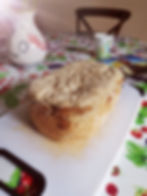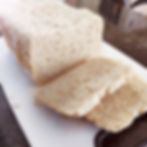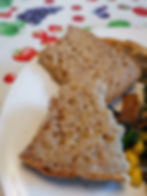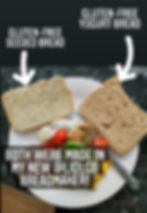Is it worth getting a breadmaker for gluten-free loaves?
- Apr 9, 2021
- 4 min read
I feel I ought to start this post with an apology.
Excluding the pic above, the photos here are awful.
Well, not awful, awful - you can at least tell I've been baking bread. But they're not quite the standard I'd wish for.
Ah, heck! You've not come here for photos. You just want to know whether it's worth buying a breadmaker so you can have some decent gluten-free bread! (And yes, there is such a thing.)
Confession! I'd been putting off getting a breadmaker for years. It's just something that'd take up more space in the kitchen, right? And we'd probably only use it once and then have it looming over us, reminding us of money down the drain.
Plus, I'd actually had one twenty years earlier with disastrous results. The bread paddle got stuck in what I can only describe as ET's head. It was the most revolting lump of uncooked dough imaginable. I tried again before giving up and gifting the breadmaker to my mum (who had marvellous results with normal bread).
But then I saw that Lidl were doing them for £50. And no sooner had I remarked upon it to my husband than he came home with one.
I was committed.
With the breadmaker came a booklet of recipes. There are 3 specifically for the gluten-free function (yay) and 3 more for alternative types of bread such as 'peanut bread', 'coconut bread' and 'almond bread' (bit of a nut theme going on here).
First up, I decided to try the seeded gluten-free loaf. As long as you put the liquids in first, they promised it would all be ok. (I wasn't convinced.)
But fast-forward 4 hours and the kitchen was singing with the aroma of a freshly-baked loaf. I couldn't wait to try it!

I wasn't disappointed. It reminded me of being small when we always used to bake bread. (My mum had cleverly found something cheap and cheerful to do that would keep 3 kids quiet long enough for her to have a cuppa and breathe for ten minutes.)

It tasted fantastic, if a little weighty, but nonetheless absolutely top-notch.
In the morning I eagerly bounded downstairs to enjoy some more, only to be greeted with a rock of a loaf that had hardened beyond belief. Thankfully, I managed to saw a slice off and, after toasting, enjoyed the same wonderful taste as the day before. (What would coeliacs do without toasters?)
I then decided to try the gluten-free yogurt loaf. This involved slightly different ingredients going in (yogurt, obviously, and some buckwheat flour as well as the gluten-free bread flour).

Once again - a wonderful loaf emerged! This time, the taste was more springy but slightly tangy. Hubby said he preferred the texture but not the taste (although he liked it overall).
Unlike recipes I'd come across before, this bread didn't have an egg in it. I used gluten-free bread flour, yeast, oil, salt, sugar, seeds (I used a blend of sesame, pumpkin and linseed) and water. For the yogurt bread I needed natural yogurt, buckwheat flour
Unlike rcipes I'd come across before, this bread didn't have an egg in it. I used gluten-free bread flour, yeast, oil, salt, sugar, seeds (I used a blend of sesame, pumpkin and linseed) and water. For the yogurt bread I needed natural yogurt, buckwheat flour and guar gum, which I didn't have so I used xanthan gum instead.
You can find similar breadmaker recipes online here. (Just click on page 10 for gluten-free.)
And if you're wondering what the difference between yogurt & seeded bread is, here you go:

You can tell that the seeded loaf has a tighter crumb. The yogurt loaf has a darker crust because I altered the settings. I'd heard 'dark crust' was the best for gluten-free bread and decided to test the theory.
)So what are the main benefits from getting a breadmaker?
You can store gluten-free bread flour & yeast for months on end which means you won't have to worry about it going stale.
You won't have to go to multiple shops to find gluten-free bread.
It's cheaper to make your own loaves.
You can set the timer on the breadmaker so that you can wake up in the morning to a freshly baked loaf (maximum 15 hours pre-set function).
It is SO easy to bake the bread. You're just pouring ingredients into the tin. That's it. The breadmaker does everything else.
You can make 3 different sizes of loaf (the above pics show the 1500g loaf - the largest it does).
You have 3 different crust settings (light, medium & dark).
It also (bizarrely) makes jam and yogurt! (Not together, mind.
There's nothing like the waft of delicious home baking!
And the disadvantages?
It takes 4 hours to bake a loaf. But that's from scratch, which is pretty similar to normal bread-making, and there's a fast setting if you're in a bit of a hurry.
It doesn't keep well unless you toast it. Expect a brick the next day.
You'll need to slice it yourself (and the crumbs go everywhere).
It doesn't make great sandwiches (if you're making them in advance for a lunchbox - see point 2).
The texture is quite dense.
Personally, I reckon I'm going to get a lot of use out of it, particularly when I set the breadmaker the night before so I can have fresh bread in the morning. That will be a joy indeed!
To hear more about gluten-free breadmakers, I'll be live on Instagram at 10am taking your questions (Friday 9th April if you need to find it on IGTV catch up).





